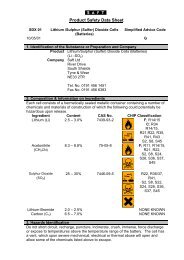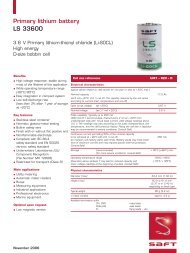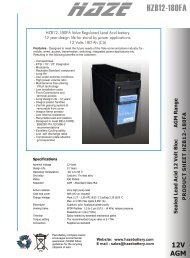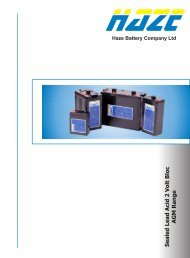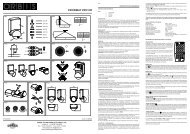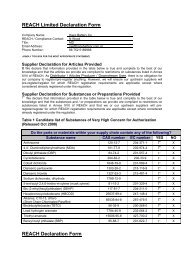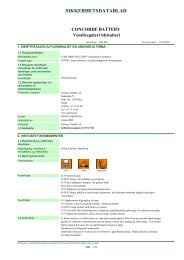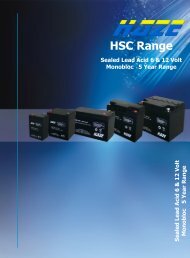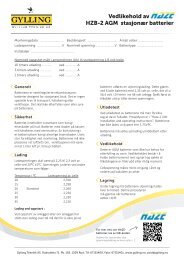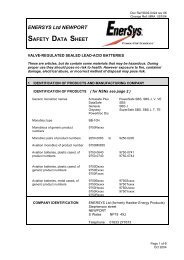MSDS Ni-MH Cylindrical (2009).pdf
MSDS Ni-MH Cylindrical (2009).pdf
MSDS Ni-MH Cylindrical (2009).pdf
- No tags were found...
Create successful ePaper yourself
Turn your PDF publications into a flip-book with our unique Google optimized e-Paper software.
Product name: <strong>Ni</strong>ckel-Metal Hydride BatteryEstablishment / Revision: Feb. 13, <strong>2009</strong>Safety data sheet for chemical products (SDS)Reference number TW-CE-E01-061.PRODUCT AND COMPANY IDENTIFICATION・Product name : <strong>Ni</strong>ckel-Metal Hydride Battery・Company name : SANYO Electric Co., Ltd. Mobile Energy Company・Address : 222-1 kaminaizen, Sumoto City, Hyogo, Japan・Telephone number : +81-799-24-4111・Telefax number : +81-799-23-2995・Emergency telephone number : [Weekday] +81-799-23-2881[<strong>Ni</strong>ght and holiday] +81-799-24-41312.HAZARDS IDENTIFICATION・Most important hazard and effectsFor the battery cell, chemical materials are stored in a hermetically sealed metal case, designed to withstandtemperatures and pressures encountered during normal use. As a result, during normal use, there is nophysical danger of ignition or explosion and chemical danger of hazardous materials' leakage.However, if exposed to a fire, added mechanical shocks, decomposed, added electric stress by misuse, thegas release vent will be operated. The battery cell case will be breached at the extreme. Hazardous materialsmay be released.Moreover, if heated strongly by the surrounding fire, acrid or harmful fume may be emitted.Human health effects:Inhalation: The electrolyte inhalation affects the respiratory tract membrane and the lugs. Cadmiumfume may cause a cough, chest pain and dyspnea. Bronchitis and pneumonia will beoccurred. Probably, it is carcinogen.Skin contact: The electrolyte skin contact affects the skin seriously and may cause dermatitis.Eye contact: The electrolyte leaked from the battery cell is strong alkali. When it goes into an eye, thecornea may be affected and it may lead to blindness.Ingestion: The electrolyte ingestion irritates the mouth and the throat seriously results in vomiting,nausea, hematemesis, stomach pains and diarrhea.Environmental effects:Since a battery cell remains in the environment, do not throw out it into the environment.・Specific hazards :As previously described.3.COMPOSITION / INFORMATION ON INGREDIENTS・Substance or preparation : Preparation・Information about the chemical nature of product :Common chemical name / CAS number Concentration /General nameHydrogen Absorbing Alloy<strong>Ni</strong>ckel-Cobalt-Zinc oxide7440-02-0(<strong>Ni</strong>)7440-48-4(Co)7439-96-5(Mn)7429-90-5(Al)7440-02-0(<strong>Ni</strong>)7440-48-4(Co)Concentration range20-40%Classification andhazard labelingspecific hazard15-25% acute toxicityspecific hazard7440-66-6(Zn)<strong>Ni</strong>ckel 7440-02-0 5-15% specific hazardIron 7439-89-6 20-40%Carbon Black 1333-86-4 0-1% specific hazardPotassium Hydroxide 1310-58-3Sodium Hydroxide 1310-73-2Lithium Hydroxide 1310-65-20-15%acute toxicitycorrosivityirritant property1
Product name: <strong>Ni</strong>ckel-Metal Hydride BatteryEstablishment / Revision: Feb. 13, <strong>2009</strong>4.FIRST-AID MEASURESInternal cell materials of an opened battery cell・Inhalation :Cover the victim in a blanket, move to the place of fresh air and keep quiet. Seek medical attentionimmediately. When dyspnea (breathing difficulty) or asphyxia (breath-hold), give artificial respirationimmediately.・Skin contact :Remove contaminated clothes and shoes immediately. Wash the adherence or contact region with soapand plenty of water. Seek medical attention immediately.・Eye contact :Immediately flush eyes with water continuously for at least 15 minutes. Seek medical attentionimmediately.A battery cell and internal cell materials of an opened battery cell・Ingestion :Do not induce vomiting. Seek medical attention immediately.5.FIRE-FIGHTING MEASUREAlthough a battery cell is not flammability, in case of fire, move it to the safe place quickly.The following measures are taken when it cannot be moved.・Suitable extinguishing media: Dry sand, chemical powder fire extinguishing medium.・Specific hazards: Acrid or harmful fume is emitted during fire.・Special protective equipment for firefighters : Protective equipment written in Section 8.6.ACCIDENTAL RELEASE MEASURESInternal cell materials, such as electrolyte leaked from battery cell, are carefully dealt with according to thefollowings.・Personal precautions :Forbid unauthorized person to enter. Remove leaked materials with protective equipment written inSection 8.・Environmental precautions: Do not throw out into the environment.・Method of recovery and neutralization :Dilute the leaked electrolyte with water and neutralize with diluted sulfuric acid. The leaked solid ismoved to a container. The leaked place is fully flushed with water.7.HANDLING AND STORAGE・HandlingTechnical measuresPrevention of user exposure: Not necessary under normal use.Prevention of fire and explosion: Not necessary under normal use.Precaution for safe handling: Do not damage or remove the external tube.Specific safe handling advice: Never throw out cells in a fire or expose to high temperatures. Do notsoak cells in water and seawater. Do not expose to strong oxidizers. Do not give a strong mechanicalshock or throw down. Never disassemble, modify or deform. Do not connect the positive terminal tothe negative terminal with electrically conductive material. In the case of charging, use only dedicatedcharger or charge according to the conditions specified by Sanyo.・StorageTechnical measuresStorage conditions (suitable to be avoided): Avoid direct sunlight, high temperature, high humidity.Store in cool place (temperature: -20 ~ 30 degree C, humidity: from 40 to 80%).Incompatible products: Conductive materials, water, seawater, strong oxidizers and strong acidsPacking material (recommended, not suitable): Insulative and tear-proof materials are recommended.8.EXPOSURE CONTROLS / PERSONAL PROTECTION・Engineering measures :No engineering measure is necessary during normal use. In case of internal cell materials' leakage, theinformation below will be useful.2
Product name: <strong>Ni</strong>ckel-Metal Hydride BatteryEstablishment / Revision: Feb. 13, <strong>2009</strong>-・Control parametersCommon chemical name /ACGIH(2007)General nameTLV-TWABEI<strong>Ni</strong>ckel, <strong>Ni</strong>ckel Compounds (As <strong>Ni</strong>)Insoluble compounds : 0.2mg/m 3Metal : 1.5mg/m 3Soluble compounds : 0.1mg/m 3Cobalt Compounds (As Co)0.02mg/m 3In urine : 15 micro g/lIn blood : 1 micro g/lManganese Compounds (As Mn)-0.2mg/m 3Aluminum Compounds (As Al)-5mg/m 3 (Flammable powder)Zinc oxide 2mg/m 3 -Carbon Black 3.5mg/m 3 -Potassium Hydroxide - -Sodium Hydroxide - -Lithium Hydroxide - -ACGIH: American Conference of Governmental Industrial Hygienists, Inc.TLV-TWA: Threshold Limit Value-time weighted average concentrationBEI: Biological Exposure Indices・Personal protective equipmentRespiratory protection: Protective maskHand protection: Protective glovesEye protection: Protective glasses designed to protect against liquid splashesSkin and body protection: Working clothes with long sleeve and long trousers9.PHYSICAL AND CHEMICAL PROPERTIES・AppearancePhysical state: SolidForm: <strong>Cylindrical</strong> and PrismaticColor: Metallic color (without tube/label)Odour: No odour・pH : NA・Specific temperatures/temperature ranges at which changes in physical state occur :There is no useful information for the product as a mixture.・Flash point : NA・Explosion properties : NA・Density : around 1.5 ~ 6.0g/cm 3・Solubility ,with indication of the solvent(s) : Insoluble in water10.STABILITY AND REACTIVITY・Stability : Stable under normal use・Hazardous reactions occurring under specific conditionsBy misuse of a battery cell or the like, oxygen or hydrogen accumulates in the cell and the internalpressure rises. These gases may be emitted through the gas release vent. When fire is near, these gasesmay take fire.When a battery cell is heated strongly by the surrounding fire, acrid or harmful fume may be emitted.・Conditions to avoid : Direct sunlight, high temperature and high humidity・Materials to avoid : Conductive materials, water, seawater, strong oxidizers and strong acids・Hazardous decomposition products: Acrid or harmful fume is emitted during fire.3
Product name: <strong>Ni</strong>ckel-Metal Hydride BatteryEstablishment / Revision: Feb. 13, <strong>2009</strong>11.TOXICOLOGICAL INFORMATIONThere is no data available on the product itself. The information of the internal cell materials is as follows.<strong>Ni</strong>ckel, <strong>Ni</strong>ckel Compounds・Acute toxicity:oral GHS: out of Category.skin Unknown.GHS: exempt from a classification.inhalation(steam) Unknown.inhalation(mist) Unknown.・Skin corrosivity : Unknown.・Seriousinhalation(gas)damage and irritant property for eyes: Unknown.・Respiratory or skin sensitization:Respiratory sensitization: GHS: Category 1The allergy, asthma or breathing difficulties might be caused when inhaling.Skin sensitization: GHS: Category 1The allergic skin reaction might be caused.・Germline mutagenicity:GHS: It is not possible to classify it due to data deficiency.・Carcinogenicity :GHS: Category 2ACGIH: (Metal) A5 – Not suspected as a human carcinogenACGIH: (water-soluble compounds) A4 – Not classified as a human carcinogen obviouslyACGIH: (Insoluble compounds) A1 – Confirmed human carcinogenNIOSH: Potential occupational carcinogenNTP: Reasonably anticipated to be human carcinogenIARC: (Metal) Group 2B Possibly carcinogenic to humanIARC: (Compounds) Group 1 carcinogenic to human・Reproduction Toxicity :GHS: It is not possible to classify it due to data deficiency.・Certain target organ/ Systemic toxicity (single exposure):GHS: Category 1(respiratory organ and kidney).The disorder of the respiratory organ and the kidney is caused.・Certain target organ/ Systemic toxicity (repeated exposure):GHS: Category 1(respiratory organ).The disorder of the respiratory organ is caused by long-term or repeated exposure.Cobalt Compounds・Acute toxicity:oralGHS: out of Category.skininhalation(gas)Unknown.GHS: exempt from ainhalation(steam)classification.inhalation(mist)Unknown.GHS: It is not possible to classify it due to data deficiency.・Skin corrosivity : Unknown.・Serious damage and irritant property for eyes: Unknown.・Respiratory or skin sensitization:Respiratory sensitization: GHS: Category 1The allergy, asthma or breathing difficulties might be caused when inhaling.Skin sensitization: GHS: Category 1The allergic skin reaction might be caused.・Germline mutagenicity: Unknown.・Carcinogenicity :GHS: Category 2ACGIH: A3 –Confirmed animal carcinogen but relevance to human carcinogen is unknown.IARC: Group 2B Possibly carcinogenic to human.The cancer might be caused.・Reproduction Toxicity :GHS: Category 2.The adverse effect on reproductive competence or the fetus might occur.4
Product name: <strong>Ni</strong>ckel-Metal Hydride BatteryEstablishment / Revision: Feb. 13, <strong>2009</strong>・Certain target organ/ Systemic toxicity (single exposure):GHS: Category 3(respiratory tract irritating properties).The respiratory organ might be stimulated.・Certain target organ/ Systemic toxicity (repeated exposure):GHS: Category 1(respiratory organ).The disorder of the respiratory organ is caused by long-term or repeated exposure.Manganese compounds・Acute toxicity:oralGHS: out of Category.skininhalation(gas)Unknown.GHS: exempt from a classification.mist)inhalation(steam, Unknown.・Skin corrosivity : GHS: Category 3. Slight skin stimulation.・Serious damage and irritant property for eyes: GHS: Category 2B. eye stimulation.・Respiratory or skin sensitization:Respiratory sensitization: Unknown.Skin sensitization: Unknown.・Germline mutagenicity : GHS: It is not possible to classify.・Carcinogenicity :GHS: out of Category.・Reproduction Toxicity : GHS: Category 1B.The adverse effect on reproductive competence or the fetus might occur.・Certain target organ/ Systemic toxicity (single exposure):GHS: Category 1(respiratory organ).The disorder of the respiratory organ is caused.・Certain target organ/ Systemic toxicity (repeated exposure):GHS: Category 1(respiratory organ, nerve).The disorder of the respiratory organ and nerve system is caused by long-term or repeatedinhalation exposure.Aluminum Compounds・Acute toxicity:oral, skin, inhalation(steam, dust) Unknown.・Skin corrosivity : Unknown.・Serious damage and irritant property for eyes: Unknown.・Respiratory or skin sensitization:Respiratory sensitization: Unknown.Skin sensitization: Unknown.・Germline mutagenicity : Unknown.・Carcinogenicity :Unknown.・Reproduction Toxicity : Unknown.・Certain target organ/ Systemic toxicity (single exposure): Unknown.・Certain target organ/ Systemic toxicity (repeated exposure):GHS: Category 1 and 2.The disorder of the pulmonary is caused by long-term or repeated inhalation exposure.(Category 1)The disorder of the nerve system by long-term or repeated oral exposure might be caused.(Category 2)mist)Zinc oxide・Acute toxicity:oralrat LD 50 > 5000mg/kginhalation(dust, rat LD 50 > 5.7mg/l The harmful might be caused when inhaling.・Skin corrosivity :GHS: out of Category.・Serious damage and irritant property for eyes: GHS: out of Category・Respiratory or skin sensitization:Respiratory sensitization: Unknown.Skin sensitization: GHS: out of Category.・Germline mutagenicity : Unknown.・Carcinogenicity :GHS: out of Category.5
Product name: <strong>Ni</strong>ckel-Metal Hydride BatteryEstablishment / Revision: Feb. 13, <strong>2009</strong>・Reproduction Toxicity : GHS: out of Category.・Certain target organ/ Systemic toxicity (single exposure):GHS: Category 1.The disorder of the whole body・Certain target organ/ Systemic toxicity (repeated exposure):GHS: Category 1.The disorder of the pulmonary is caused by long-term or repeated inhalation exposure.Carbon Black・Acute toxicity:oralrat LD 50 15400 mg/kgskininhalation(dust)Unknown.Unknown.・Skin corrosivity : Unknown.・Serious damage and irritant property for eyes: Unknown.・Respiratory or skin sensitization:Respiratory sensitization: Unknown.Skin sensitization: Unknown.・Germline mutagenicity : Unknown.・Carcinogenicity :GHS: Category 2ACGIH: A3 –Confirmed animal carcinogen but relevance to human carcinogen is unknown.IARC: Group 2B Possibly carcinogenic to human.The cancer might be caused.・Reproduction Toxicity : Unknown.・Certain target organ/ Systemic toxicity (single exposure): Unknown.・Certain target organ/ Systemic toxicity (repeated exposure):GHS: Category 1The disorder of the pulmonary is caused by long-term or repeated inhalation exposure.Potassium Hydroxide・Acute toxicity:oralGHS: Category 3. Harmful if swallowed.skin GHS: It is not possible toinhalation(steam)classify.GHS: It is not possible to classify.GHS: It is not possible to classify.・Skin corrosivity : GHS: Category 1B.Serious chemical wound of the skin and damage of eyes is caused.・Serious damage and irritant property for eyes: GHS: Category 1.・Respiratoryinhalation(dust)or skin sensitization:Respiratory sensitization: GHS: It is not possible to classify.Skin sensitization: GHS: out of Category.・Germline mutagenicity : GHS: out of Category.・Carcinogenicity :GHS: It is not possible to classify.・Reproduction Toxicity : GHS: It is not possible to classify.・Certain target organ/ Systemic toxicity (single exposure):GHS: Category 1.The disorder of the respiratory system is caused.・Certain target organ/ Systemic toxicity (repeated exposure)GHS: It is not possible to classify.Sodium Hydroxide・Acute toxicity:oralGHS: It is not possible to classify.skin GHS: It is not possible to classify.GHS: out ofinhalation(steam)Category.inhalation(dust)Unknown.Unknown.・Skin corrosivity : GHS: Category 1.inhalation(gas)6
Product name: <strong>Ni</strong>ckel-Metal Hydride BatteryEstablishment / Revision: Feb. 13, <strong>2009</strong>Serious chemical wound of the skin and damage of eyes is caused.・Serious damage and irritant property for eyes: GHS: Category 1.Serious damage of eyes is caused.・Respiratory or skin sensitization:Respiratory sensitization: GHS: It is not possible to classify.Skin sensitization: GHS: out of Category.・Germline mutagenicity : GHS: out of Category・Carcinogenicity :GHS: It is not possible to classify.・Reproduction Toxicity : GHS: It is not possible to classify.・Certain target organ/ Systemic toxicity (single exposure):GHS: Category 1(respiratory system).The disorder of the respiratory organ is caused.・Certain target organ/ Systemic toxicity (repeated exposure):GHS: It is not possible to classify.Lithium Hydroxide・Acute toxicity:oralGHS: Category 3. Harmful if swallowed.skininhalation(steam)Unknown.Unknown.GHS: Category 3. Harmful if inhaled.・Skin corrosivity : GHS: Category 1.Serious chemical wound of the skin and damage of eyes is caused.・Serious damage and irritant property for eyes: GHS: Category 1.・Respiratoryinhalation(dust)or skin sensitization:Respiratory sensitization: GHS: It is not possible to classify.Skin sensitization: GHS: It is not possible to classify.・Germline mutagenicity : Unknown.・Carcinogenicity :Unknown.・Reproduction Toxicity : Unknown.・Certain target organ/ Systemic toxicity (single exposure):GHS: Category 1.The disorder of the respiratory system is caused by inhalation exposure.・Certain target organ/ Systemic toxicity (repeated exposure):GHS: Category 1&2.The disorder of the respiratory system is caused by long-term or repeated inhalationexposure. The disorder of the liver and the hematopoietic system by long-term or repeatedoral exposure might be caused.12.ECOLOGICAL INFORMATION・Persistence/degradability :Since a battery cell and the internal materials remain in the environment, do not bury or throw out intothe environment.13.DISPOSAL CONSIDERATIONS・Recommended methods for safe and environmentally preferred disposal :Product (waste from residues)Do not throw out a used battery cell. Recycle it through the recycling company.Contaminated packagingNeither a container nor packing is contaminated during normal use. When internal materials leakedfrom a battery cell contaminates them, dispose them as industrial wastes subject to special control.14.TRANSPORT INFORMATIONThis battery doesn't correspond to dangerous article of the United Nations transportation regulations.Moreover, this article doesn't correspond to dangerous article to which transportation is restricted bythe following decree and guideline.7
Product name: <strong>Ni</strong>ckel-Metal Hydride BatteryEstablishment / Revision: Feb. 13, <strong>2009</strong>・TECHNICAL INSTRUCTIONS FOR THE SAFE TRANSPORT OF DANGEROUS GOODS BY AIR(ICAO)・IATA Dangerous Goods Regulations(IATA)・INTERNATIONAL MARITIME DANGEROUS GOODS CODE(IMO)・code of federal regulations (U.S.DOT)In the case of transportation, confirm no leakage and no spillage from a container. Take in a cargo of themwithout falling, dropping and breakage. Prevent collapse of cargo piles and wet by rain. The container mustbe handled carefully. Do not give shocks that result in a mark of hitting on a cell. Moreover, take theprotection measures not short-circuited. Please refer to Section 7-HANDLING AND STORAGE also.15.REGULATORY INFORMATION・Regulations specifically applicable to the product :Wastes Management and Public Cleaning Law (Japan)Law for Promotion Effective Utilization of Resources (Japan)Commission Directive 2006/66/EU (EU)16.OTHER INFORMATION・The information contained in this Safety data sheet is based on the present state of knowledge andcurrent legislation.・This safety data sheet provides guidance on health, safety and environmental aspects of the product andshould not be construed as any guarantee of technical performance or suitability for particularapplications.・ReferenceChemical substances information: Japan Advanced Information center of Safety and HealthInternational Chemical Safety Cards (ICSCs):International Occupational Safety and Health Information Center (CIS)2005 TLVs and BEIs : American Conference of Governmental Industrial Hygienists (ACGIH)NIOSH CARCINOGEN LIST: National Institute for Occupational Safety and Health (NIOSH)The <strong>Ni</strong>nth Report on Carcinogen: National Toxicology Program (NTP)IARC Monographs Program on the Evaluation of Carcinogenic Risks to Humans:International Agency for Research on Cancer (IARC)Globally Harmonized System of Classification and Labelling of Chemicals(GHS)National Institute of Technology and Evaluation(NITE)First edition Dec. 1, 2003Latest edition Feb. 13, <strong>2009</strong>Prepared and approved bySANYO Electric Co., Ltd.Mobile Energy CompanyAlkaline Battery DivisionTwicell Engineering Department8



